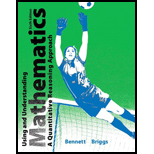
Redistricting and House Elections. The 2010 census led to the loss of two House seats in New York and Ohio. the loss of House seat in Pennsylvania. the gain of two House seats in Florida, and the gain of four House seats in Texas. Consider the following approximate vote counts for all House districts in these states in 2010 (before redistricting) and 2012 (after redistricting). All figures are in
thousands of votes. Votes for other parties are neglected.
a. Find the percentages of votes cast for Republican and Democratic House candidates in 2010 and 2012.
b. Find the percentages of House seats that were won by Republican and Democratic candidates in 2010 and 2012.
c. Explain whether the distributions of votes reflect the distributions of House seats.
d. Discuss whether redistricting based on the 2010 census affected the distributions of votes and representatives.
16. New Work
| Votes for Republican Candidates (1000s) |
Votes for Democratic Candidates (1000s) |
Republican Seats |
Democratic Seats |
|
| 2010 | 1612 | 2515 | 4 | 25 |
| 2012 | 1733 | 3898 | 2 | 23 |
Want to see the full answer?
Check out a sample textbook solution
Chapter 12 Solutions
Using and Understanding Mathematics: A Quantitative Reasoning Approach plus NEW MyMathLab with Pearson eText -- Access Card Package (6th Edition) (Bennett Science & Math Titles)
- The graph of f(x) is given below. Select each true statement about the continuity of f(x) at x = 3. Select all that apply: 7 -6- 5 4 3 2 1- -7-6-5-4-3-2-1 1 2 3 4 5 6 7 +1 -2· 3. -4 -6- f(x) is not continuous at a = 3 because it is not defined at x = 3. ☐ f(x) is not continuous at a = - 3 because lim f(x) does not exist. 2-3 f(x) is not continuous at x = 3 because lim f(x) ‡ ƒ(3). →3 O f(x) is continuous at a = 3.arrow_forward1.5. Run Programs 1 and 2 with esin(x) replaced by (a) esin² (x) and (b) esin(x)| sin(x)|| and with uprime adjusted appropriately. What rates of convergence do you observe? Comment.arrow_forwardIs the function f(x) continuous at x = 1? (z) 6 5 4 3. 2 1 0 -10 -9 -7 -5 -2 -1 0 1 2 3 4 5 6 7 8 9 10 -1 -2 -3 -4 -5 -6 -7 Select the correct answer below: ○ The function f(x) is continuous at x = 1. ○ The right limit does not equal the left limit. Therefore, the function is not continuous. ○ The function f(x) is discontinuous at x = 1. ○ We cannot tell if the function is continuous or discontinuous.arrow_forward
- Use Taylor Series to derive the entries to the pentadiagonal and heptadiagonal (septadiagonal?) circulant matricesarrow_forwardIs the function f(x) shown in the graph below continuous at x = −5? f(x) 7 6 5 4 2 1 0 -10 -9 -8 -7 -6 -5 -4 -3 -2 -1 0 1 2 3 4 5 6 7 8 9 10 -1 -2 -3 -4 -5 -6 -7 Select the correct answer below: The function f(x) is continuous. ○ The right limit exists. Therefore, the function is continuous. The left limit exists. Therefore, the function is continuous. The function f(x) is discontinuous. ○ We cannot tell if the function is continuous or discontinuous.arrow_forward1.3. The dots of Output 2 lie in pairs. Why? What property of esin(x) gives rise to this behavior?arrow_forward
- 1.6. By manipulating Taylor series, determine the constant C for an error expansion of (1.3) of the form wj−u' (xj) ~ Ch¼u (5) (x;), where u (5) denotes the fifth derivative. Based on this value of C and on the formula for u(5) (x) with u(x) = esin(x), determine the leading term in the expansion for w; - u'(x;) for u(x) = esin(x). (You will have to find maxε[-T,T] |u(5) (x)| numerically.) Modify Program 1 so that it plots the dashed line corresponding to this leading term rather than just N-4. This adjusted dashed line should fit the data almost perfectly. Plot the difference between the two on a log-log scale and verify that it shrinks at the rate O(h6).arrow_forward4. Evaluate the following integrals. Show your work. a) -x b) f₁²x²/2 + x² dx c) fe³xdx d) [2 cos(5x) dx e) √ 35x6 3+5x7 dx 3 g) reve √ dt h) fx (x-5) 10 dx dt 1+12arrow_forwardDefine sinc(x) = sin(x)/x, except with the singularity removed. Differentiate sinc(x) once and twice.arrow_forward
- 1.4. Run Program 1 to N = 216 instead of 212. What happens to the plot of error vs. N? Why? Use the MATLAB commands tic and toc to generate a plot of approximately how the computation time depends on N. Is the dependence linear, quadratic, or cubic?arrow_forwardShow that the function f(x) = sin(x)/x has a removable singularity. What are the left and right handed limits?arrow_forward18.9. Let denote the boundary of the rectangle whose vertices are -2-2i, 2-21, 2+i and -2+i in the positive direction. Evaluate each of the following integrals: (a). 之一 dz, (b). dz, (b). COS 2 coz dz, dz (z+1) (d). z 2 +2 dz, (e). (c). (2z+1)zdz, z+ 1 (f). £, · [e² sin = + (2² + 3)²] dz. (2+3)2arrow_forward
 Functions and Change: A Modeling Approach to Coll...AlgebraISBN:9781337111348Author:Bruce Crauder, Benny Evans, Alan NoellPublisher:Cengage Learning
Functions and Change: A Modeling Approach to Coll...AlgebraISBN:9781337111348Author:Bruce Crauder, Benny Evans, Alan NoellPublisher:Cengage Learning Holt Mcdougal Larson Pre-algebra: Student Edition...AlgebraISBN:9780547587776Author:HOLT MCDOUGALPublisher:HOLT MCDOUGAL
Holt Mcdougal Larson Pre-algebra: Student Edition...AlgebraISBN:9780547587776Author:HOLT MCDOUGALPublisher:HOLT MCDOUGAL Glencoe Algebra 1, Student Edition, 9780079039897...AlgebraISBN:9780079039897Author:CarterPublisher:McGraw Hill
Glencoe Algebra 1, Student Edition, 9780079039897...AlgebraISBN:9780079039897Author:CarterPublisher:McGraw Hill


